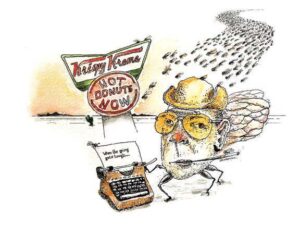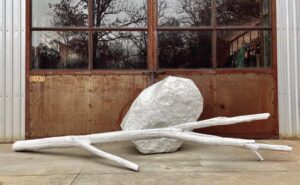
The Homecoming
Putting guru David Orr brings his fantastic fundamentals back to Pine Needles
By Lee Pace
On a December afternoon, David Orr peers around the building and the wall space at the Pine Needles Golf Learning Center at the far end of the resort’s practice range. There is an enlarged version of a vintage American Golfer magazine cover featuring Peggy Kirk Bell, who owned the resort for some 60 years prior to her death in 2016. There is a 1920s photo of the par-3 third hole at Pine Needles. There are assorted other charts and images tied to the business of golf instruction.
Finally, Orr finds an uncluttered spot with no decorations or adornments.
“Here,” he says. “They can sign their names right here.”
Over a decade of teaching putting and the short game to more than 60 Tour professionals from his previous headquarters at Campbell University in Buies Creek, Orr established a tradition of having his clients sign and date a wall in his putting studio.
Justin Rose has been there. So have Hunter Mahan, Cheyenne Woods, Suzanne Pettersen, Edoardo Molinari and Trevor Immelman.
“It started when I was working with some guys who were pretty much unknown, were trying to get established on the Web.com Tour or European and Asian tours,” Orr says. “I told them, ‘I want your autograph before you become famous.’ Then I started working with guys further up the World Rankings — Justin and Hunter, guys like that. The wall kind of represents my development as a coach. It’s pretty cool.”
Orr’s career as a swing coach and putting guru has essentially came full circle in the fall of 2017 as he relocated his Flatstick Academy teaching and coaching business back to Pine Needles, where he was on the instruction staff from 2000-04 and learned the business under the tutelage of Mrs. Bell and a staff that included Pat McGowan, a PGA Tour regular from 1978-91, and Chip King, who’s gone on to become director of golf at Grandfather Golf & Country Club.
“This is a homecoming for me,” Orr says. “I think of Peggy every day. Every day. I stand on the range and look around and say, ‘Wow, every brick, every blade of grass — they’re here because of her.’ She built the dream. You cannot replace her. But it’s an honor to be back.”
Kelly Miller, the CEO of the company that owns and operates Pine Needles and its sister resort, Mid Pines, plays frequently in top amateur tournaments and last summer needed some help with his golf swing. He invited Orr to drive down from Buies Creek and look at his swing — and talk a little business. Miller had been following Orr on Facebook and on Orr’s Flatstick Academy website and saw references to golfers traveling to Buies Creek for a lesson.
“I thought, why not have those people come to Pine Needles if David is operating from here?” Miller says.
He took a 15-minute full-swing lesson from Orr, who got Miller’s swing plane adjusted from laid-off to on-line, and threw out the idea. Miller proposed that Orr could still have the freedom to teach at Campbell, work with his professional clients and travel as he does around the world to speak at instruction conferences.
But the rest of the time, he would use Pine Needles’ facilities for his individual and group lessons focusing on putting, chipping, pitching and bunker play. He would also operate multi-day short-game schools and consult with the Pine Needles staff in running the resort’s well-known golf instruction programs.
“This is a unique opportunity to get someone of David’s skill and reputation to come here,” Miller says. “David is certainly one of the top two or three putting instructors in the United States. He’ll bring some energy and an exciting niche to what we’re already doing.”
Orr says his experience working at the top level of the PGA Tour has given him a sense of accomplishment that makes the move back to Pine Needles a comfortable one at this juncture of his career. He helped Rose with his putting and short game, and then watched as Rose won the 2013 U.S. Open. A year later, he followed as Rose went head-to-head against another of his clients, Mahan, in the Ryder Cup.
“I don’t have to prove myself any longer,” Orr says. “Early on, I was like a salmon swimming upstream. Now it’s cool to step on a practice tee on tour and think, ‘I don’t have to prove anything.’ I have so much fun working with amateur golfers and juniors. I can help some younger guys and borrow from my experiences the last 10 years.”
Orr is a native of upstate New York, played college golf at Bridgewater in Virginia, and then graduated in 1991 from Oswego State in New York with a degree in political science. That summer he was working at a club in Syracuse and was impressed by the wad of hundred-dollar bills the head pro was making on the lesson tee. The idea of becoming a golf instructor lingered in the back of his mind the next several years as he played the mini-tours, and Orr eventually moved to Raleigh and worked at Cheviot Hills and North Ridge Country Club.
“I was still playing some on the mini-tour in the mid-90s when I was giving lessons at Cheviot Hills,” he says. “I won one mini-tour event but was making more teaching than playing.”
Orr joined Mrs. Bell’s teaching staff at Pine Needles in 2000 and learned over four years that there was more to teaching than simply applying the highly technical dictums from two of the enduring influences on his own swing — PGA Tour player Mac O’Grady and Homer Kelley’s book, The Golfing Machine.
“I got to Pine Needles with a lot of science in my head and learned from Peggy the art of teaching,” Orr says. “‘How-to’ instruction doesn’t work all that well. The brilliant ‘ah-ha moment’ with Peg was her drumming it into my head that you need to get students to do something in order to learn it. I can remember, David, get them out there doing it. That was a huge turning point. I learned to make instruction palatable so that people could understand it and improve.”
Orr left in 2004 to take classes in the Professional Golf Management program at Campbell and obtain his Class A-6 PGA status, which he did in 2007. He joined the Campbell faculty and became director of instruction for the PGM program, and during the late 2000s began doing extensive research into putting — from technique to equipment to green reading.
One of his motivations to crack the putting code was the fact that his own putting ability had been, in his word, “terrible” over his competitive career.
“I was terrible for many of the same reasons everyone else is,” he says. “You miss a couple short ones and you get down on yourself and all of a sudden you’re afraid. I used to avoid practicing putting. I changed putters and grips and changed my stroke. I’d go take lessons. The more I tried, the worse I got. That’s how I came to a turning point. I did the research and started teaching putting.”
One of the significant developments for him was learning the SAM PuttLab system, which uses 3-D technology to analyze some 28 parameters of the putting stroke and displays the results in easy to understand graphic reports. He and Dr. Rob Neal of Golf BioDynamics pioneered research on the working of the hands, wrists, forearms and upper arms in the putting stroke. That research became the basis for Neal’s GDB 3-D System, which in the last decade has taken putting stroke and full-swing analysis to new technical levels.
“My teaching method is based on research, not on theory,” Orr says. “I offer very little ‘how-to’ information. One of the things I learned from using SAM was, ‘Never guess what you can measure.’ That’s one of my policies: I don’t guess.”
Orr evaluates each golfer and offers suggestions and direction based on analysis of three key skills to holing a putt: Can a player read a green? How good are they adjusting to speeds of greens? And are they able to start the ball on-line?
“Those are the three skills — read, speed and line,” says Orr. “With each element, we take the guesswork out. We measure it. Then we take what you have and make it the best it can be. There is no perfect putting technique — except your own.”
Orr turns 50 in 2018 and says he’s at the perfect place at Pine Needles to write the next chapter of his teaching career. Indeed, there’s a blank space of wall in his new putting lab just awaiting some signatures. PS
Chapel Hill-based golf writer Lee Pace has been writing “Golftown Journal” since 2008.





